Albi Cathedral
The Cathedral Basilica of Saint Cecilia (French: Basilique Cathédrale Sainte-Cécile d'Albi), also known as Albi Cathedral, is the most important Catholic building in Albi, France and is the seat of the Catholic Archbishop of Albi. First built as a fortress in the aftermath of the Albigensian Crusade; begun in 1282 and under construction for 200 years, it is claimed to be the largest brick building in the world.[1]
| Cathedral of Saint Cecilia of Albi Cathédrale Sainte-Cécile d'Albi | |
|---|---|
View of Albi Cathedral | |
| Religion | |
| Affiliation | Catholic Church |
| Province | Archdiocese of Albi within Ecclesiastical Province of Tolouse |
| Region | Midi-Pyrénées |
| Rite | Latin |
| Ecclesiastical or organizational status | Cathedral |
| Leadership | Jean Legrez |
| Status | Active |
| Location | |
| Location | Place Sainte-Cécile, Albi, France |
| Geographic coordinates | 43.928492°N 2.142945°E |
| Architecture | |
| Type | church |
| Style | Southern French Gothic, Romanesque |
| Groundbreaking | 1282 |
| Completed | 1480 |
| Specifications | |
| Length | 113,5 m (372,4 ft) |
| Width | 35 m (114,8 ft) |
| Height (max) | 78 m (255,9 ft) |
| Materials | red brick |
| Official name | Cathédrale Sainte-Cécile d'Albi |
| Location | Europe |
| Criteria | Cultural: (ii), (iv), (vi) |
| Inscription | 2010 (34th session) |
In 2010 the cathedral was designated a UNESCO World Heritage Site.
History
The present cathedral was preceded by other buildings. The first dated from the fourth century and in 666 was destroyed by fire. The second is recorded in 920 by the name of Saint Cecilia, the present-day patroness of musicians. It was replaced in the thirteenth century by a Gothic cathedral in stone.[2]
The Southern French Gothic cathedral was constructed in brick between 1282 and 1480 in the wake of the crusade against Catharism, a heterodox non-trinitarian dualist movement with an episcopal see at Albi around 1165 AD.[3] Pope Innocent III initiated a crusade to extinguish Catharism in southern France, with great loss of life.[4] In the aftermath of the crusade, the cathedral's dominant presence and fortress-like exterior made of brick were intended to demonstrate the authority of the Catholic Church, to protect its sanctuary by thick walls, and to convey a sense of poverty in response to Catharism. The instigator of the cathedral's construction was Bernard de Castanet, Catholic Bishop of Albi and Inquisitor of Languedoc. Work on the nave was completed about 1330.[5]
Features
The cathedral is built in the Southern French Gothic style. As suitable building stone is not found locally, the structure is built almost entirely of brick. Notable architectural features include the bell-tower (added in 1492), which stands 78 metres (256 ft) tall, and the doorway by Dominique de Florence (added circa 1392). The nave is the widest Gothic example in France at 18 metres (59 ft). The interior lacks aisles which are replaced by rows of small chapels between brick internal buttresses, making Albi a hall church. Compared with regular Gothic, the buttresses are almost entirely submerged in the mass of the church. The principal entry is on the south side through an elaborate porch entered by a fortified stair, rather than through the west front, as is traditional in France.[6]
The side chapels in the nave received overhead galleries in the 15th century, diminishing their impact.[5]
The elaborate interior stands in stark contrast to the cathedral's military exterior. The central chœur, reserved for members of the clergy, is surrounded by a roodscreen with detailed filigree stone work and a group of polychrome statues. Below the organ, a fresco of the Last Judgement, attributed to unknown Flemish painters, originally covered nearly 200 m2 (the central area was later removed). The frescoes on the enormous vaulted ceiling comprise the largest and oldest ensemble of Italian Renaissance painting in France.
The cathedral organ, the work of Christophe Moucherel, dates from the 18th century.
Gallery

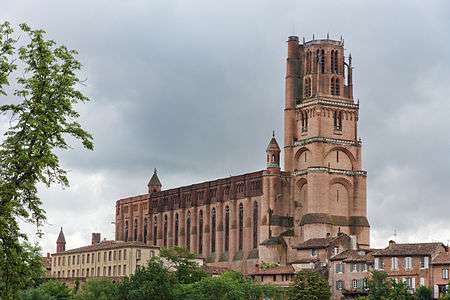 Global view of the cathedral and its surroundings
Global view of the cathedral and its surroundings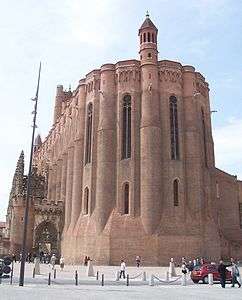 Closer view of the cathedral external walls
Closer view of the cathedral external walls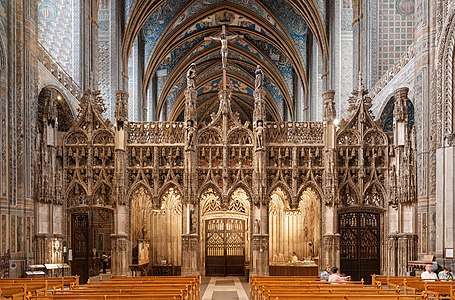 The gothic roodscreen
The gothic roodscreen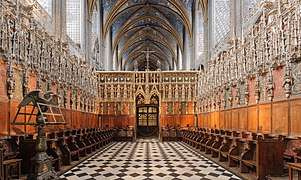 Choir and rood screen of the cathedral.
Choir and rood screen of the cathedral. The cathedral's nave and organ.
The cathedral's nave and organ.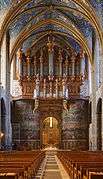 Organ and nave.
Organ and nave.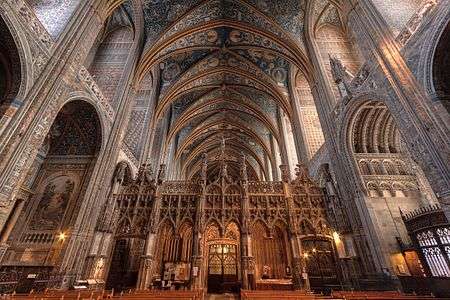 Nave
Nave
See also
- Albi
- Tourism in Tarn
- List of Gothic Cathedrals in Europe
References
- Holly Haynes, "Albi Cathedral", Sacred Destinations
- The municipal park in Rochegude has some remains of its cloister arcade.
- O'Shea (2000), pp. 2–4.
- Weber, Nicholas. "Albigenses." The Catholic Encyclopedia. Vol. 1. New York: Robert Appleton Company, 1907. 14 Oct. 2013
- Kurmann, Peter (2010). "Late Gothic Architecture in France and the Netherlands". In Toman, Rolf (ed.). Gothic Architecture, Sculpture, Painting. Potsdam: H.F. Ullmann. pp. 162–163. ISBN 978-3-8331-1038-2.
- Cruickshank, Dan, ed. (1996). Sir Banister Fletcher's A History of Architecture (20th ed.). Architectural Press. pp. 432, 443. ISBN 0-7506-2267-9.
External links
| Wikimedia Commons has media related to Albi Cathedral. |
- Cathédrale Sainte-Cécile d'Albi, Tourist Office site
- Panoramic virtual tour inside the cathedral
- High-resolution 360° Panoramas and Images of the Albi Cathedral | Art Atlas